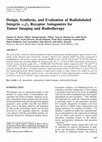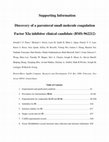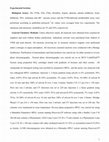Papers by Jeffrey Bozarth

Cancer Biotherapy and Radiopharmaceuticals, 2003
The goal of this research is the development of tumor imaging and radiotherapeutic agents based o... more The goal of this research is the development of tumor imaging and radiotherapeutic agents based on targeting of the integrin a v b 3 (vitronectin receptor). Macrocyclic chelator DOTA has been conjugated to peptidomimetic vitronectin receptor antagonist SH066 to give TA138. TA138 and 89 Y-TA138 retain antagonist properties and high affinity for integrin a v b 3 (IC 50 5 12 and 18 nM, respectively), and good selectivity versus integrin a IIb b 3 (IC 50. 10,000 nM). TA138 forms stable complexes with 111 In and 90 Y in .95% RCP. 111 In-TA138 demonstrates high tumor uptake in the c-neu Oncomouse ® (Charles River Laboratories [Charles River, Canada]) mammary adenocarcinoma model (9.39% ID/g at 2 hours PI) and low background activity. Blood clearance is rapid and excretion is renal. Tumors are visible as early as 0.5 hours PI. Radiotherapy studies in the c-neu Oncomouse ® model demonstrated a slowing of tumor growth at a dose of 15 mCi/m 2 , and a regression of tumors at a dose of 90 mCi/m 2 .
Journal of Medicinal Chemistry

Blood
Apixaban, previously known as BMS-562247, is a high affinity, highly selective, orally-active, re... more Apixaban, previously known as BMS-562247, is a high affinity, highly selective, orally-active, reversible inhibitor of coagulation factor Xa (fXa), in clinical studies as a therapeutic agent for prevention and treatment of thromboembolic diseases. The in vitro characteristics of apixaban were evaluated in purified systems and in human blood from healthy volunteers. Detailed kinetic analysis of apixaban inhibition of human fXa showed that it is a readily reversible, potent and competitive inhibitor versus a synthetic tripeptide substrate with a Ki of 0.08 nM, an association rate of 2 × 107 M−1s−1and a dissociation half life of 3.4 min. Weak affinity (Ki ~3 μM) is observed for thrombin, plasma kallikrein, and chymotrypsin. Affinity for trypsin and all other serine proteases tested is negligible with Ki > 15 μM. Apixaban is an effective inhibitor of free fXa and of prothrombinase, in buffer, platelet poor plasma, and whole blood. The anticoagulant activity of apixaban was determined...
Journal of Medicinal Chemistry
Bioorganic & Medicinal Chemistry Letters
Bioorganic & medicinal chemistry letters, 2018
Pyridazine and pyridazinone derivatives were designed and synthesized as coagulation factor XIa i... more Pyridazine and pyridazinone derivatives were designed and synthesized as coagulation factor XIa inhibitors. Potent and selective inhibitors with single digit nanomolar affinity for factor XIa were discovered. Selected inhibitors demonstrated moderate oral bioavailability.

Journal of medicinal chemistry, Jan 14, 2017
Factor XIa (FXIa) is a blood coagulation enzyme that is involved in the amplification of thrombin... more Factor XIa (FXIa) is a blood coagulation enzyme that is involved in the amplification of thrombin generation. Mounting evidence suggests that direct inhibition of FXIa can block pathologic thrombus formation while preserving normal hemostasis. Preclinical studies using a variety of approaches to reduce FXIa activity, including direct inhibitors of FXIa, have demonstrated good antithrombotic efficacy without increasing bleeding. On the basis of this potential, we targeted our efforts at identifying potent inhibitors of FXIa with a focus on discovering an acute antithrombotic agent for use in a hospital setting. Herein we describe the discovery of a potent FXIa clinical candidate, 55 (FXIa Ki = 0.7 nM), with excellent preclinical efficacy in thrombosis models and aqueous solubility suitable for intravenous administration. BMS-962212 is a reversible, direct, and highly selective small molecule inhibitor of FXIa.
Journal of Medicinal Chemistry
A novel series of macrocyclic FXIa inhibitors was designed based on our lead acyclic phenyl imida... more A novel series of macrocyclic FXIa inhibitors was designed based on our lead acyclic phenyl imidazole chemotype. Our initial macrocycles, which were double-digit nanomolar FXIa inhibitors, were further optimized with assistance from utilization of structure-based drug design and ligand bound X-ray crystal structures. This effort resulted in the discovery of a macrocyclic amide linker which was found to form a key hydrogen bond with the carbonyl of Leu41 in the FXIa active site, resulting in potent FXIa inhibitors. The macrocyclic FXIa series, exemplified by compound 16, had a FXIa K= 0.16 nM with potent anticoagulant activity in an in vitro clotting assay (aPTT EC= 0.27 μM) and excellent selectivity against the relevant blood coagulation enzymes.
Bioorganic & Medicinal Chemistry Letters
A series of macrocyclic factor XIa (FXIa) inhibitors was designed based on an analysis of the cry... more A series of macrocyclic factor XIa (FXIa) inhibitors was designed based on an analysis of the crystal structures of the acyclic phenylimidazole compounds. Further optimization using structure-based design led to inhibitors with pM affinity for FXIa, excellent selectivity against a panel of relevant serine proteases, and good potency in the activated partial thromboplastin time (aPTT) clotting assay.
Bioorganic & medicinal chemistry letters, Aug 23, 2017
Optimization of macrocyclic inhibitors of FXIa is described which focused on modifications to bot... more Optimization of macrocyclic inhibitors of FXIa is described which focused on modifications to both the macrocyclic linker and the P1 group. Increases in potency were discovered through interactions with a key hydrophobic region near the S1 prime pocket by substitution of the macrocyclic linker with small alkyl groups. Both the position of substitution and the absolute stereochemistry of the alkyl groups on the macrocyclic linker which led to improved potency varied depending on the ring size of the macrocycle. Replacement of the chlorophenyltetrazole cinnamide P1 in these optimized macrocycles reduced the polar surface area and improved the oral bioavailability for the series, albeit at the cost of a decrease in potency.
Bioorganic & Medicinal Chemistry Letters, 2017
Factor VIIa (FVIIa) inhibitors have shown strong antithrombotic efficacy in preclinical thrombosi... more Factor VIIa (FVIIa) inhibitors have shown strong antithrombotic efficacy in preclinical thrombosis models with limited bleeding liabilities. Discovery of potent, orally active FVIIa inhibitors has been largely unsuccessful due to the requirement of a basic P1 group to interact with Asp189 in the S1 binding pocket, limiting their membrane permeability. We have combined recently reported neutral P1 binding substituents with a highly optimized macrocyclic chemotype to produce FVIIa inhibitors with low nanomolar potency and enhanced permeability.

ACS Medicinal Chemistry Letters, 2016
Experimental Sections Biological Assays. The FVIIa, FXa, FXIa, thrombin, trypsin, plasmin, plasma... more Experimental Sections Biological Assays. The FVIIa, FXa, FXIa, thrombin, trypsin, plasmin, plasma kallikrein, tissue kallikrein, TPA, urokinase and aPC enzyme assays and the FVIIa-deficient prothrombin assay were performed according to published protocols. 5 Ki values were averaged from two experiments. The intraassay and interassay variabilities are 5% and 20%, respectively. General Chemistry Methods. Unless otherwise stated, all materials were obtained from commercial suppliers and used without further purification. Anhydrous solvents were purchased from Aldrich or VWR and used directly. All reactions involving air-or moisture sensitive reagents were performed under a nitrogen or argon atmosphere. All microwave assisted reactions were conducted with a Biotage Synthesizer. Purification of intermediates and final products was carried out via either normal or reverse phase chromatography. Normal phase chromatography was carried out on an ISCO CombiFlash™ System using prepacked SiO 2 cartridges eluted with gradients of hexanes and ethyl acetate. All compounds for biological testing were purified by preparative HPLC, and the purity was analyzed with two orthogonal HPLC conditions: Injection 1: a linear gradient using solvent A (5% acetonitrile, 95% water, 0.05% TFA) and solvent B (95% acetonitrile, 5% water, 0.05% TFA); 10-100% of solvent B over 10 min and then 100% of solvent B over 5 min. Column: Sunfire C18 3.5 µm (4.6 x 150 mm). Flow rate was 2 ml/min. and UV detection was set to 220 nm; Injection 2: a linear gradient using solvent A (5% acetonitrile, 95% water, 0.05% TFA) and solvent B (95% acetonitrile, 5% water, 0.05% TFA); 10-100% of solvent B over 10 min and then 100% of solvent B over 5 min. Column: Xbridge Phenyl 3.5 µm (4.6 x 150 mm). Flow rate was 2 ml/min. and UV detection was set to 220 nm. The columns were maintained at room temperature. Reverse phase preparative HPLC was carried out using a Shimadzu Preparative HPLC system running DiscoveryVP software using with a Sunfire 5 µm C18 30x100 mm column, a Phenomenex AXIA Luna 5 µm C18 30 x 75 mm column, or a Phenomenex Luna 5 µm C18 30 x 100 mm column with either methanol/water/0.1% TFA or acetonitrile/water/0.1%TFA as eluents. LCMS chromatograms were obtained on a Shimadzu HPLC system running DiscoveryVP
Coronary Artery Dis, 1998
DIAGNOSTIC METHODS Novel technetium-99m-labeled platelet GPIIb/llla receptor antagonists as poten... more DIAGNOSTIC METHODS Novel technetium-99m-labeled platelet GPIIb/llla receptor antagonists as potential imaging agents for venous and arterial thrombosis Shaker A. Mousaa, Jeff M. Bozarth3, Scott Edwards0, Timothy Carroll0 and John Barrett0 Objectives Either venous ...

The Journal of Clinical Pharmacology, Jul 1, 2003
Low molecular weight heparins (LMWHs) stimulate the release of endothelial tissue factor pathway ... more Low molecular weight heparins (LMWHs) stimulate the release of endothelial tissue factor pathway inhibitor (TFPI). An inhibitor of tissue factor-induced coagulation, TFPI may contribute to the efficacy of LMWHs. The release of TFPI may be affected by characteristics of LMWHs, such as molecular weight (MW) distribution. The authors measured plasma levels of TFPI after single, subcutaneous injections of tinzaparin (mean MW = 6500 Daltons [Da]; 3.5% of fractions < 2000 Da) or a tinzaparin-like LMWH (mean MW = 5650 Da; 18.3% of fractions < 2000 Da) in 30 healthy subjects. Maximum mean plasma levels of TFPI approached 200 to 230 ng/mL 0.8 hours after administration of either drug. Plasma levels of TFPI remained elevated compared with baseline values for 12 to 16 hours after drug administration. These results suggest that LMWH fractions < 2000 Da do not affect the release of TFPI.
Bioorganic & Medicinal Chemistry Letters, 2015
The synthesis, structural activity relationships (SAR), and selectivity profile of a potent serie... more The synthesis, structural activity relationships (SAR), and selectivity profile of a potent series of phenylalanine diamide FXIa inhibitors will be discussed. Exploration of P1 prime and P2 prime groups led to the discovery of compounds with high FXIa affinity, good potency in our clotting assay (aPPT), and high selectivity against a panel of relevant serine proteases as exemplified by compound 21. Compound 21 demonstrated good in vivo efficacy (EC50=2.8μM) in the rabbit electrically induced carotid arterial thrombosis model (ECAT).

ACS Medicinal Chemistry Letters, 2015
Structure-activity relationship optimization of phenylalanine P1&... more Structure-activity relationship optimization of phenylalanine P1' and P2' regions with a phenylimidazole core resulted in a series of potent FXIa inhibitors. Introducing 4-hydroxyquinolin-2-one as the P2' group enhanced FXIa affinity and metabolic stability. Incorporation of an N-methyl piperazine amide group to replace the phenylalanine improved both FXIa potency and aqueous solubility. Combination of the optimization led to the discovery of FXIa inhibitor 13 with a FXIa K i of 0.04 nM and an aPTT EC2x of 1.0 μM. Dose-dependent efficacy (EC50 of 0.53 μM) was achieved in the rabbit ECAT model with minimal bleeding time prolongation.

The Journal of pharmacology and experimental therapeutics, 1987
In this study the causal relationship between alpha-1 adrenoceptor activation mediating contracti... more In this study the causal relationship between alpha-1 adrenoceptor activation mediating contraction in rat aorta and the mediatory responses, such as phosphatidylinositol turnover and intracellular Ca++ release has been evaluated. Norepinephrine (1 X 10(-5) M) increased maximally the accumulation of [3H]inositol-1-PO4. In the presence of LiCl (10 mM) the norepinephrine-induced accumulation of [3H]inositol-1-PO4 occurred in a time-dependent, linear fashion (0-60 min), achieving a 13-fold increase over the unstimulated control at 60 min of exposure. This stimulation could be inhibited by prazosin (1 X 10(-7) M) but not by yohimbine (1 X 10(-7) M), whereas it was also unaffected by nifedipine (3 X 10(-7) M). Potassium depolarization did not invoke [3H]inositol-1-PO4 production nor did Sgd 101/75 in concentrations of up to 3 X 10(-5) M, although both have been found effective in stimulating a large influx of Ca++ for their contraction. However, the effect of norepinephrine on the format...
Journal of medicinal chemistry, Jan 26, 2015
A multidisciplinary, fragment-based screening approach involving protein ensemble docking and bio... more A multidisciplinary, fragment-based screening approach involving protein ensemble docking and biochemical and NMR assays is described. This approach led to the discovery of several structurally diverse, neutral surrogates for cationic factor VIIa P1 groups, which are generally associated with poor pharmacokinetic (PK) properties. Among the novel factor VIIa inhibitory fragments identified were aryl halides, lactams, and heterocycles. Crystallographic structures for several bound fragments were obtained, leading to the successful design of a potent factor VIIa inhibitor with a neutral lactam P1 and improved permeability.

The Journal of pharmacology and experimental therapeutics, 1998
Recent advances in the development of i.v. platelet glycoprotein alphaIIb/beta3 integrin (GPIIb/I... more Recent advances in the development of i.v. platelet glycoprotein alphaIIb/beta3 integrin (GPIIb/IIIa) antagonists led to the development of either a class of small-molecular-weight antagonists with a short to ultra-short duration of antiplatelet effects (Integrelin, Tirofiban, DMP728) or a very long-acting antagonist (ReoPro). Thus the present study was undertaken to characterize the antiplatelet efficacy of a small-molecule GPIIb/IIIa antagonist, DMP754/XV459, and to determine its platelet GPIIb/IIIa receptor binding profiles. DMP754, upon its conversion with esterases to its free acid form XV459, and XV459 itself, demonstrated high potency (IC50 = 0.030-0.060 microM) in inhibiting human platelet aggregation induced by ADP (100 microM), thrombin receptor agonist peptide (10 microM) or collagen (20 microgram/ml) in citrate or heparin. Maximal platelet aggregation inhibition was achieved at 50 to >/=80% receptor occupancy, depending on the agonist used. Both XV459 and c7E3 bind wi...

Uploads
Papers by Jeffrey Bozarth